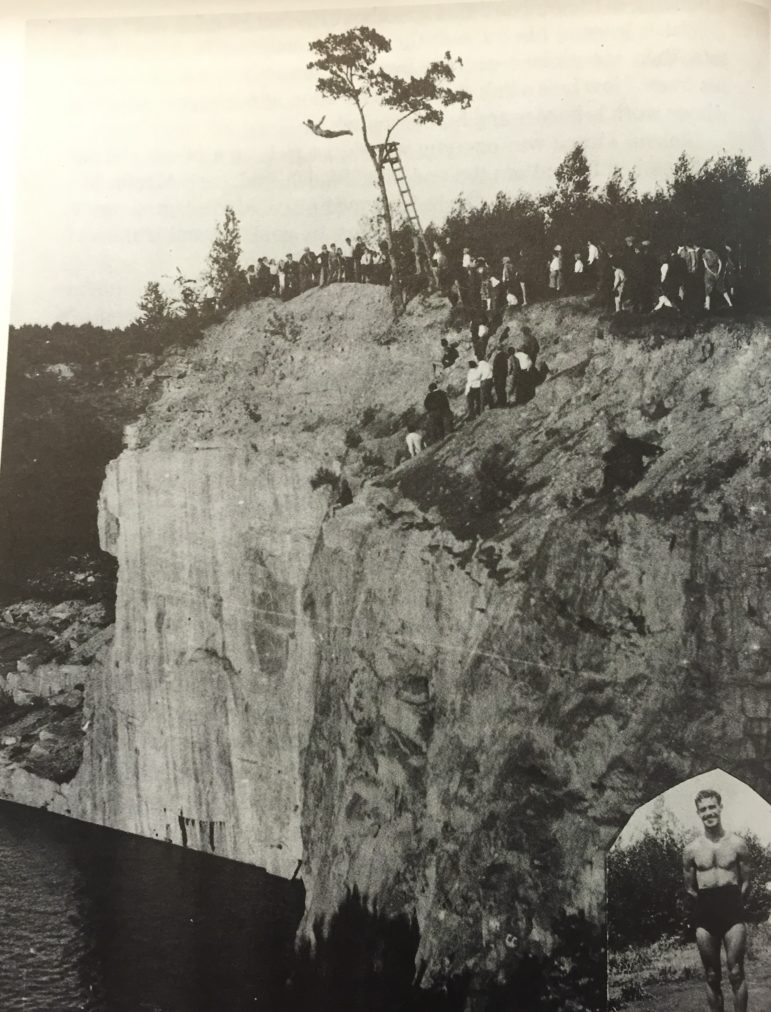
When I last saw the place,
The scenes was all changed,
Like the change in my face.”
I weep for the youth of Manchester.
Summer is here. The humidity is rising. Temperatures are soaring, but still, my heart aches as I gaze out the window and watch the children as they march in uninspired lockstep to the oh-so-civilized concrete swimming holes that The Beverly Hillbillies’ Elly May Clampett – the pride of Bug Tussle – so artfully described as ”cee-ment ponds.”
It’s so sad.
Call me a romantic, but the antiseptic aroma of chlorine just can’t compete with the, um, musky scent of the Piscataquog River I knew as a child, and the measly tweet of a lifeguard’s whistle is no match for the blood-curdling scream of a young man who is hurtling toward the water at warp speed, eyes closed in anticipation of the inevitable – striking the fictional wreckage of a B&M freight train that folklore placed somewhere beneath the pilings of The Trestle at Kelley Falls.
Now that’s swimming.
Of course, we swam at The Trestle in defiance of a parental edict, which is probably what made it so much fun. Alas, The Trestle is gone now, due in part to the efforts of the Piscataquog River Association, whose members once patrolled the area in heavily-armed motor launches as if under the direction of the Libyan Coast Guard.
Although The Trestle was the place to earn your spurs, there were other places to swim in the Piscataquog, provided, of course, you weren’t afraid of getting the DTs – those being diphtheria and typhus.
Down below Kelley Falls, for instance, you could go skinny dipping at John Brown’s or wait for the high water to subside and splash about in the natural rock pool known as The Bucket, and up-river, you could get your feet wet at Nurse’s Hole in Grasmere.
Maybe you preferred Maxwell’s Pond – now gone – or Black Brook or McCarthy’s Ledge or Steven’s Pond, but there were plenty of untamed options long after the WPA workers finished the Dupont Pool in 1934.
The mighty Merrimack offered alternatives, too. There was Sandy Beach just below Stark Park, and if you remember the old covered bridge that loomed above the Amoskeag Falls, you probably remember ”The Rocks,” which was home to Baby Hole, Monkey Hole and Devil’s Hole.
There’s a good chance you voted for F.D.R. or Wendell Wilkie if you can remember when an 18-minute trolley ride from City Hall would get you into the waters of Pine Island Pond, and if the park was too crowded, there was always the thrill of swimming au naturel in Cohas Brook.
Then again, the City’s South End offered other options like Mosquito Pond – a far more colorful name than the wimpy, generic Crystal Lake – and let’s not forget Nutt’s Pond. I can’t. The last time I came out of the water there, I looked like Humphrey Bogart in The African Queen, only I didn’t have Katharine Hepburn to help get the leeches off my body.
Yes, everybody had their favorite swimming hole, but none was as well known, as sinister, as infamous as The Amoskeag Ledge.
Who knows what evil lurked in the bottom of the watery granite quarry? Well, Hector Boisvert probably did, but he found out the hard way. He drowned there in 1929 and his body was never recovered, an event that simply added to the spooky mystery of The Ledge.
To kids, the place was Lourdes. To adults, it was Loch Ness, but for the benefit of newcomers, here’s a quick history of the place that was known as Company Hill before the quarry men from Amoskeag Manufacturing started chipping away at it.
Company Hill produced gobs of granite, but in 1883, according to oral histories, the removal of a large granite slab near the bottom of the quarry literally opened the floodgates.
A tool boy at the site named Daniel Cronin ran for his life, as did the other workmen. Yes, they left almost as fast as at quitting time, leaving everything behind, even their Coppertone.
To the dismay of Amoskeag officials, the quarry had to be abandoned, and it didn’t take long for adventurous swimmers to claim the site as their own. They weren’t content to merely paddle in the water, however. The presence of sheer granite cliffs was too enticing for local daredevils, who figured quite logically that if stock brokers could dive out of skyscrapers in New York, Amoskeag Brownies could dive off cliffs at The Ledge.

The accompanying photograph, which was published on the front page of the German newspaper Der Tageblatts, shows one of the legendary Brownies making the dive from 108 feet. The diver is my grandfather, Ted Leafe.
I believe this photo does two things. Number one, it proves that insanity does indeed run in my family, but more importantly, for our purposes here today, it shows the magnetic allure of the place that Mayor Josaphat T. Benoit once described as ”a physical and moral menace.”
As if that declaration wasn’t damning enough, once the Amoskeag Co. backed out of its dollar-per-year leasing arrangement with the Brownies in 1930, official efforts to keep swimmers away from the place probably created more problems than the swimmers themselves.
Instead of doing the obvious – like leaking word that the place was filled with giant mutant squid – city officials concocted a variety of hare-brained schemes to discourage swimming.
First there was the Exxon Valdez Variation, whereby the city would dump a layer of used crankcase oil atop the waters to inhibit mosquitoes, swimmers and other carbon-based life forms, then the Plastique Pyrotechnics Plan, where the city considered blasting the sides to fill the quarry with stones.
Dumb enough for you? Wait, it gets worse. Later on, there was the Boston Harbor Hypothesis, in which the city would use the place as a dump, heaping trash into the watery void until it was filled.
In the wake of the Hurricane of 1938, they even dumped tons of fallen trees and stumps into the waters at The Ledge. That brilliant move soon backfired when the debris became water-logged. There it sat, semi-submerged, suspended in the water like so many depth charges, waiting to croak unrepentant divers.
When measured against those standards, I guess the ultimate decision to fill the pool with soil from the West Side’s Blueberry Hill was the most practical, but today, if I walk along Super Brownie Path and see the chain link fence, the barbed wire and Maginot Line concertina wire, I just can’t shake the feeling of deja vu.
I know. It sort of reminds me of one of those ”cee-ment ponds.”

John Clayton is Executive Director of the Manchester Historic Association. You can reach him with your historical (or existential) questions at jclayton@manchesterhistoric.org.
 You’re one click away! Sign up for our free eNewsletter and never miss another thing
You’re one click away! Sign up for our free eNewsletter and never miss another thing







